Health Care Ethics - Assignment PDF
VerifiedAdded on 2021/06/17
|9
|2300
|144
AI Summary
Contribute Materials
Your contribution can guide someone’s learning journey. Share your
documents today.
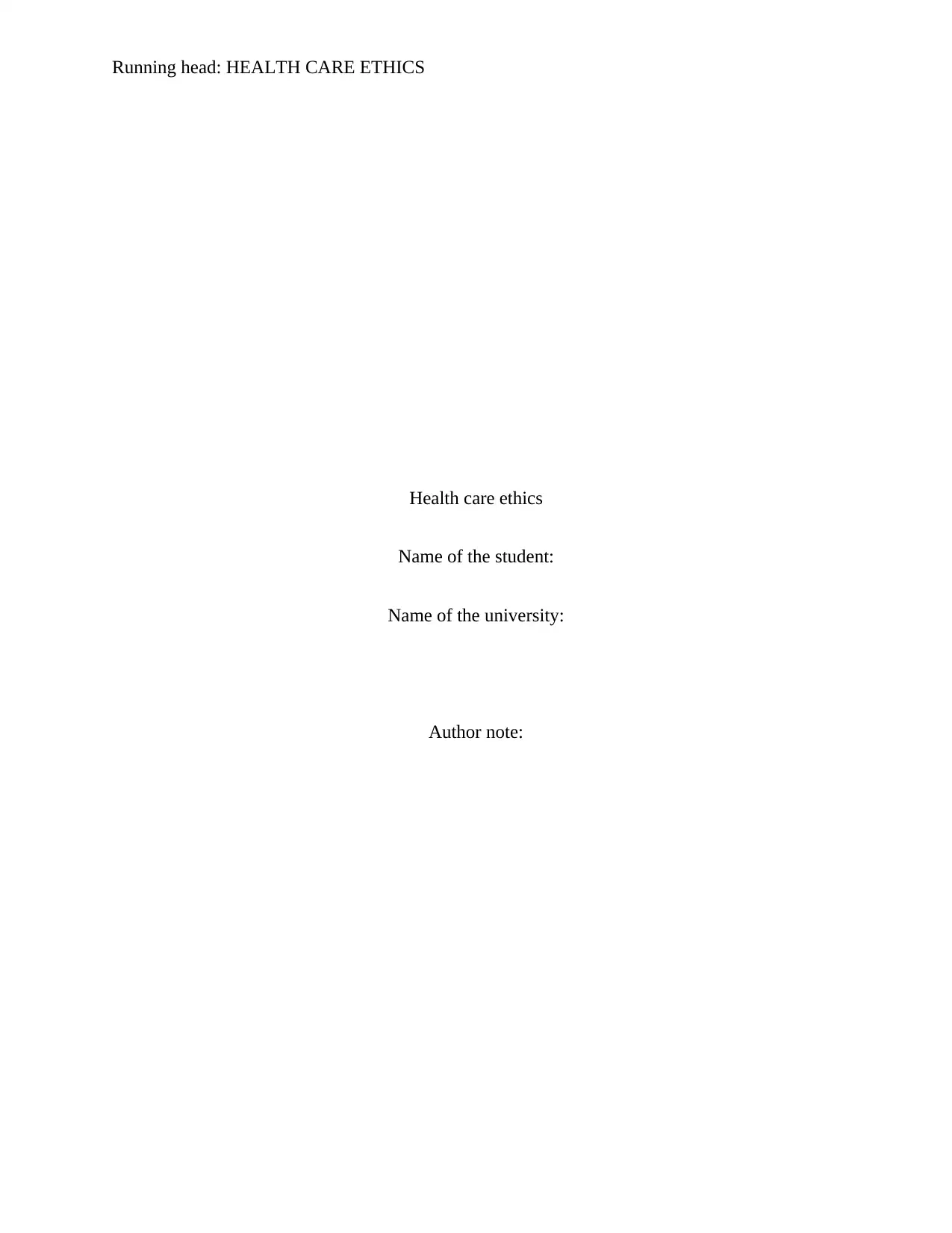
Running head: HEALTH CARE ETHICS
Health care ethics
Name of the student:
Name of the university:
Author note:
Health care ethics
Name of the student:
Name of the university:
Author note:
Secure Best Marks with AI Grader
Need help grading? Try our AI Grader for instant feedback on your assignments.
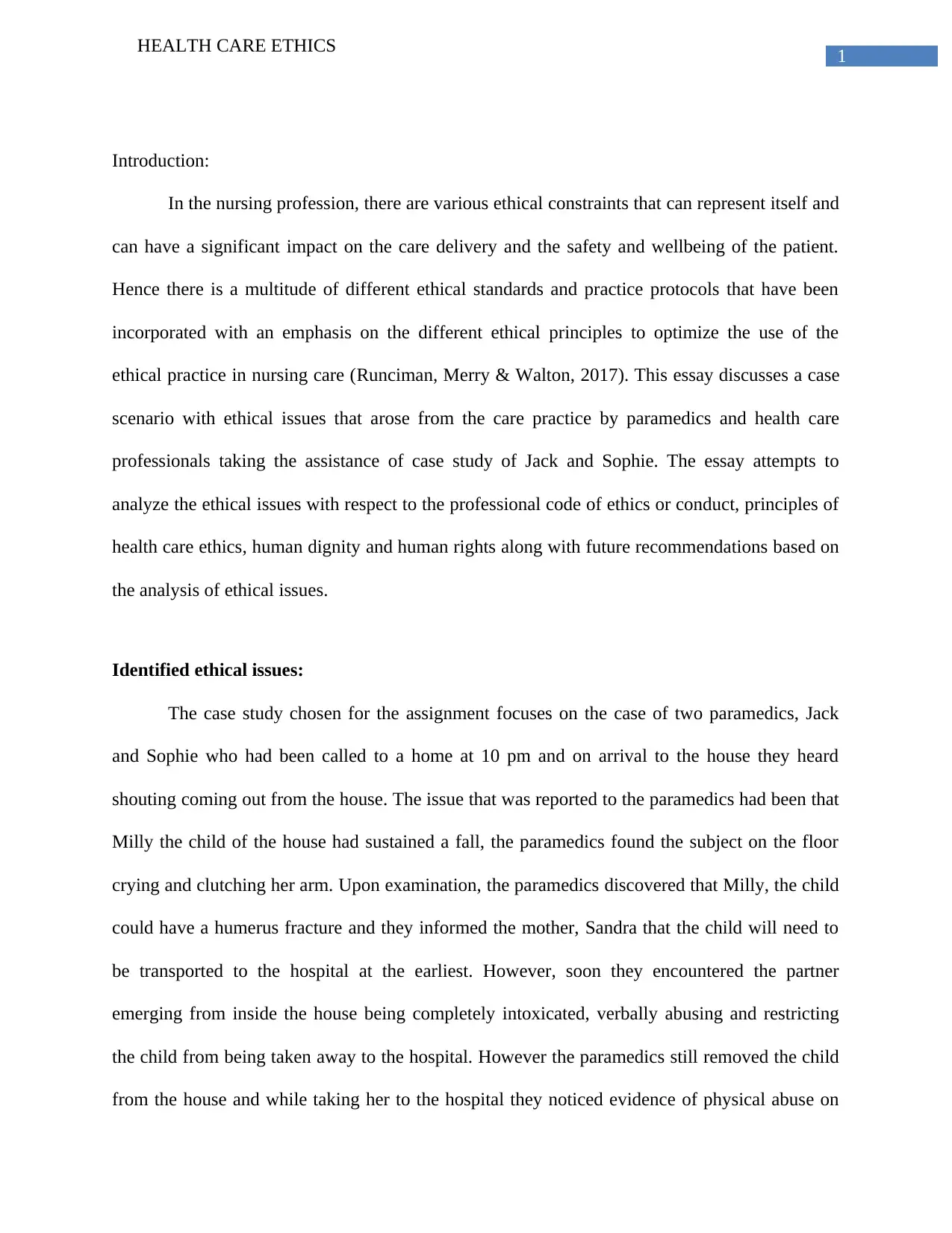
1
HEALTH CARE ETHICS
Introduction:
In the nursing profession, there are various ethical constraints that can represent itself and
can have a significant impact on the care delivery and the safety and wellbeing of the patient.
Hence there is a multitude of different ethical standards and practice protocols that have been
incorporated with an emphasis on the different ethical principles to optimize the use of the
ethical practice in nursing care (Runciman, Merry & Walton, 2017). This essay discusses a case
scenario with ethical issues that arose from the care practice by paramedics and health care
professionals taking the assistance of case study of Jack and Sophie. The essay attempts to
analyze the ethical issues with respect to the professional code of ethics or conduct, principles of
health care ethics, human dignity and human rights along with future recommendations based on
the analysis of ethical issues.
Identified ethical issues:
The case study chosen for the assignment focuses on the case of two paramedics, Jack
and Sophie who had been called to a home at 10 pm and on arrival to the house they heard
shouting coming out from the house. The issue that was reported to the paramedics had been that
Milly the child of the house had sustained a fall, the paramedics found the subject on the floor
crying and clutching her arm. Upon examination, the paramedics discovered that Milly, the child
could have a humerus fracture and they informed the mother, Sandra that the child will need to
be transported to the hospital at the earliest. However, soon they encountered the partner
emerging from inside the house being completely intoxicated, verbally abusing and restricting
the child from being taken away to the hospital. However the paramedics still removed the child
from the house and while taking her to the hospital they noticed evidence of physical abuse on
HEALTH CARE ETHICS
Introduction:
In the nursing profession, there are various ethical constraints that can represent itself and
can have a significant impact on the care delivery and the safety and wellbeing of the patient.
Hence there is a multitude of different ethical standards and practice protocols that have been
incorporated with an emphasis on the different ethical principles to optimize the use of the
ethical practice in nursing care (Runciman, Merry & Walton, 2017). This essay discusses a case
scenario with ethical issues that arose from the care practice by paramedics and health care
professionals taking the assistance of case study of Jack and Sophie. The essay attempts to
analyze the ethical issues with respect to the professional code of ethics or conduct, principles of
health care ethics, human dignity and human rights along with future recommendations based on
the analysis of ethical issues.
Identified ethical issues:
The case study chosen for the assignment focuses on the case of two paramedics, Jack
and Sophie who had been called to a home at 10 pm and on arrival to the house they heard
shouting coming out from the house. The issue that was reported to the paramedics had been that
Milly the child of the house had sustained a fall, the paramedics found the subject on the floor
crying and clutching her arm. Upon examination, the paramedics discovered that Milly, the child
could have a humerus fracture and they informed the mother, Sandra that the child will need to
be transported to the hospital at the earliest. However, soon they encountered the partner
emerging from inside the house being completely intoxicated, verbally abusing and restricting
the child from being taken away to the hospital. However the paramedics still removed the child
from the house and while taking her to the hospital they noticed evidence of physical abuse on
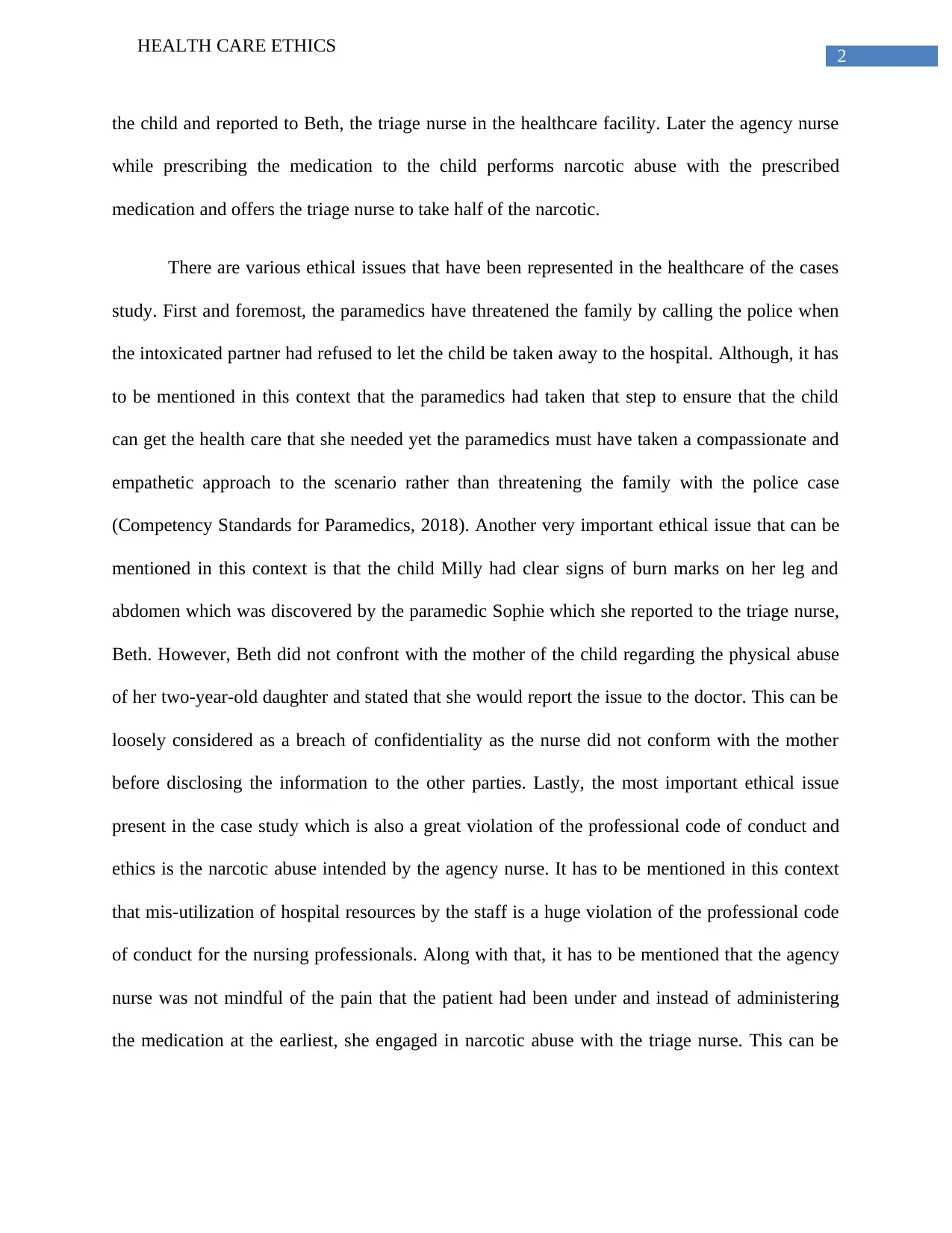
2
HEALTH CARE ETHICS
the child and reported to Beth, the triage nurse in the healthcare facility. Later the agency nurse
while prescribing the medication to the child performs narcotic abuse with the prescribed
medication and offers the triage nurse to take half of the narcotic.
There are various ethical issues that have been represented in the healthcare of the cases
study. First and foremost, the paramedics have threatened the family by calling the police when
the intoxicated partner had refused to let the child be taken away to the hospital. Although, it has
to be mentioned in this context that the paramedics had taken that step to ensure that the child
can get the health care that she needed yet the paramedics must have taken a compassionate and
empathetic approach to the scenario rather than threatening the family with the police case
(Competency Standards for Paramedics, 2018). Another very important ethical issue that can be
mentioned in this context is that the child Milly had clear signs of burn marks on her leg and
abdomen which was discovered by the paramedic Sophie which she reported to the triage nurse,
Beth. However, Beth did not confront with the mother of the child regarding the physical abuse
of her two-year-old daughter and stated that she would report the issue to the doctor. This can be
loosely considered as a breach of confidentiality as the nurse did not conform with the mother
before disclosing the information to the other parties. Lastly, the most important ethical issue
present in the case study which is also a great violation of the professional code of conduct and
ethics is the narcotic abuse intended by the agency nurse. It has to be mentioned in this context
that mis-utilization of hospital resources by the staff is a huge violation of the professional code
of conduct for the nursing professionals. Along with that, it has to be mentioned that the agency
nurse was not mindful of the pain that the patient had been under and instead of administering
the medication at the earliest, she engaged in narcotic abuse with the triage nurse. This can be
HEALTH CARE ETHICS
the child and reported to Beth, the triage nurse in the healthcare facility. Later the agency nurse
while prescribing the medication to the child performs narcotic abuse with the prescribed
medication and offers the triage nurse to take half of the narcotic.
There are various ethical issues that have been represented in the healthcare of the cases
study. First and foremost, the paramedics have threatened the family by calling the police when
the intoxicated partner had refused to let the child be taken away to the hospital. Although, it has
to be mentioned in this context that the paramedics had taken that step to ensure that the child
can get the health care that she needed yet the paramedics must have taken a compassionate and
empathetic approach to the scenario rather than threatening the family with the police case
(Competency Standards for Paramedics, 2018). Another very important ethical issue that can be
mentioned in this context is that the child Milly had clear signs of burn marks on her leg and
abdomen which was discovered by the paramedic Sophie which she reported to the triage nurse,
Beth. However, Beth did not confront with the mother of the child regarding the physical abuse
of her two-year-old daughter and stated that she would report the issue to the doctor. This can be
loosely considered as a breach of confidentiality as the nurse did not conform with the mother
before disclosing the information to the other parties. Lastly, the most important ethical issue
present in the case study which is also a great violation of the professional code of conduct and
ethics is the narcotic abuse intended by the agency nurse. It has to be mentioned in this context
that mis-utilization of hospital resources by the staff is a huge violation of the professional code
of conduct for the nursing professionals. Along with that, it has to be mentioned that the agency
nurse was not mindful of the pain that the patient had been under and instead of administering
the medication at the earliest, she engaged in narcotic abuse with the triage nurse. This can be
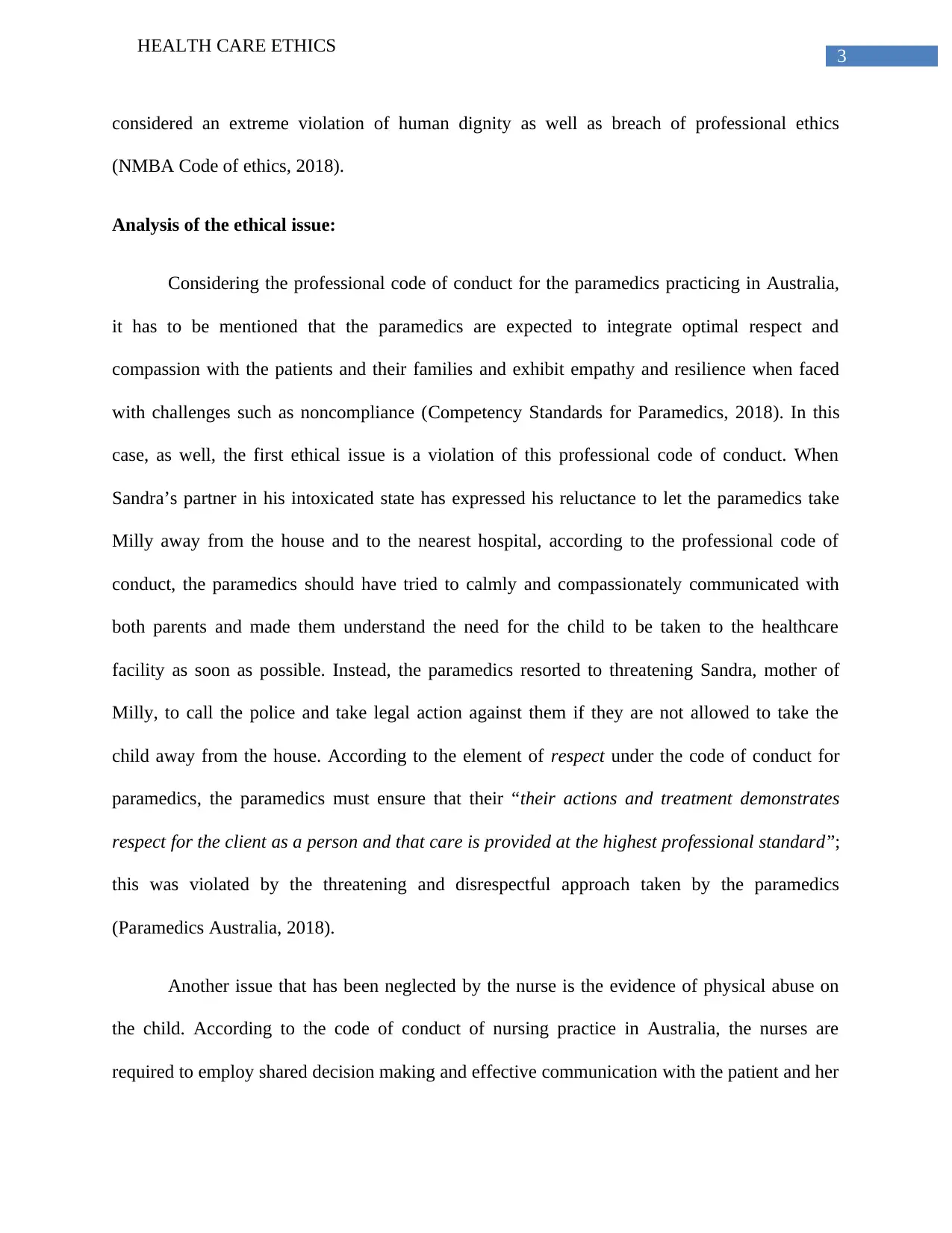
3
HEALTH CARE ETHICS
considered an extreme violation of human dignity as well as breach of professional ethics
(NMBA Code of ethics, 2018).
Analysis of the ethical issue:
Considering the professional code of conduct for the paramedics practicing in Australia,
it has to be mentioned that the paramedics are expected to integrate optimal respect and
compassion with the patients and their families and exhibit empathy and resilience when faced
with challenges such as noncompliance (Competency Standards for Paramedics, 2018). In this
case, as well, the first ethical issue is a violation of this professional code of conduct. When
Sandra’s partner in his intoxicated state has expressed his reluctance to let the paramedics take
Milly away from the house and to the nearest hospital, according to the professional code of
conduct, the paramedics should have tried to calmly and compassionately communicated with
both parents and made them understand the need for the child to be taken to the healthcare
facility as soon as possible. Instead, the paramedics resorted to threatening Sandra, mother of
Milly, to call the police and take legal action against them if they are not allowed to take the
child away from the house. According to the element of respect under the code of conduct for
paramedics, the paramedics must ensure that their “their actions and treatment demonstrates
respect for the client as a person and that care is provided at the highest professional standard”;
this was violated by the threatening and disrespectful approach taken by the paramedics
(Paramedics Australia, 2018).
Another issue that has been neglected by the nurse is the evidence of physical abuse on
the child. According to the code of conduct of nursing practice in Australia, the nurses are
required to employ shared decision making and effective communication with the patient and her
HEALTH CARE ETHICS
considered an extreme violation of human dignity as well as breach of professional ethics
(NMBA Code of ethics, 2018).
Analysis of the ethical issue:
Considering the professional code of conduct for the paramedics practicing in Australia,
it has to be mentioned that the paramedics are expected to integrate optimal respect and
compassion with the patients and their families and exhibit empathy and resilience when faced
with challenges such as noncompliance (Competency Standards for Paramedics, 2018). In this
case, as well, the first ethical issue is a violation of this professional code of conduct. When
Sandra’s partner in his intoxicated state has expressed his reluctance to let the paramedics take
Milly away from the house and to the nearest hospital, according to the professional code of
conduct, the paramedics should have tried to calmly and compassionately communicated with
both parents and made them understand the need for the child to be taken to the healthcare
facility as soon as possible. Instead, the paramedics resorted to threatening Sandra, mother of
Milly, to call the police and take legal action against them if they are not allowed to take the
child away from the house. According to the element of respect under the code of conduct for
paramedics, the paramedics must ensure that their “their actions and treatment demonstrates
respect for the client as a person and that care is provided at the highest professional standard”;
this was violated by the threatening and disrespectful approach taken by the paramedics
(Paramedics Australia, 2018).
Another issue that has been neglected by the nurse is the evidence of physical abuse on
the child. According to the code of conduct of nursing practice in Australia, the nurses are
required to employ shared decision making and effective communication with the patient and her
Secure Best Marks with AI Grader
Need help grading? Try our AI Grader for instant feedback on your assignments.
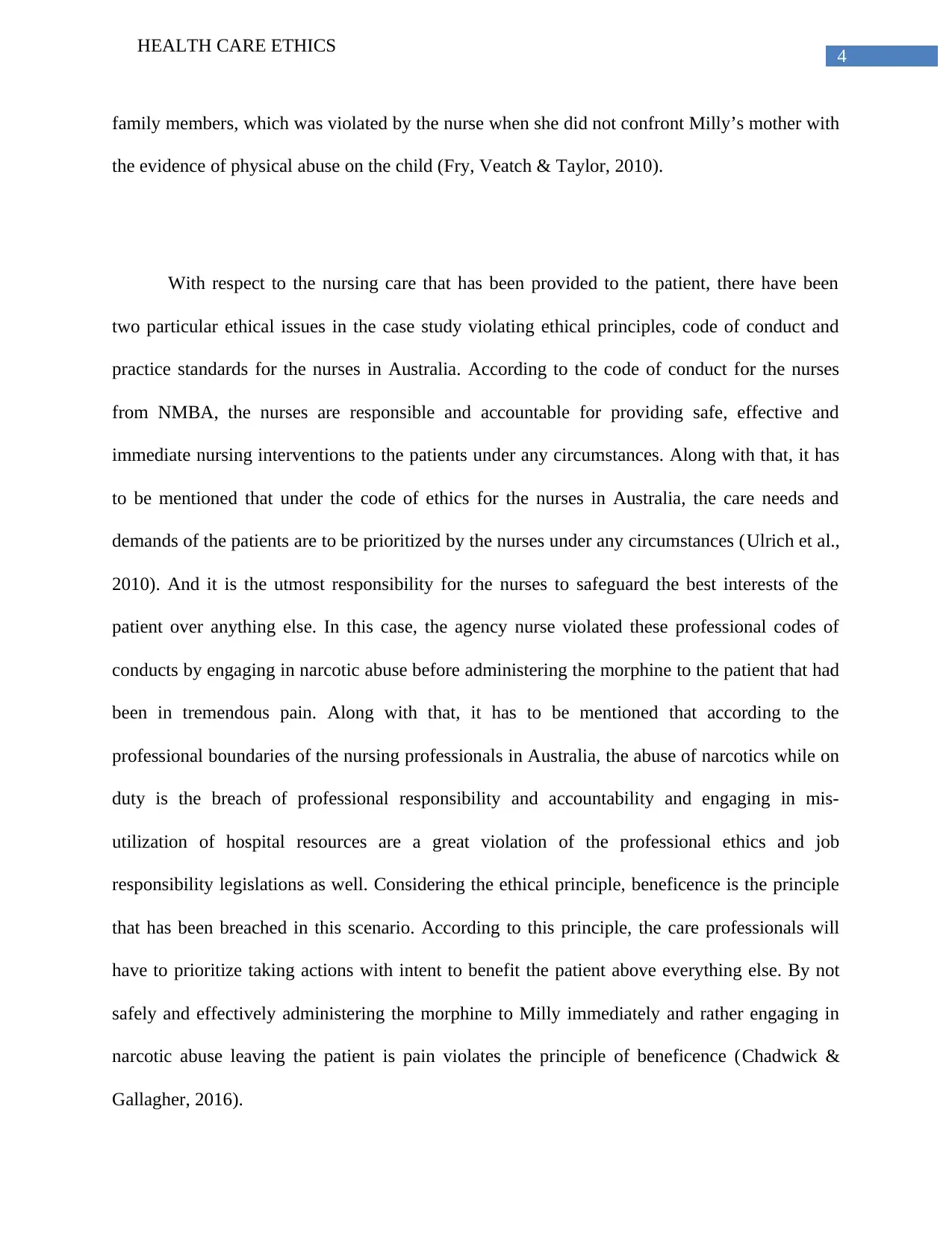
4
HEALTH CARE ETHICS
family members, which was violated by the nurse when she did not confront Milly’s mother with
the evidence of physical abuse on the child (Fry, Veatch & Taylor, 2010).
With respect to the nursing care that has been provided to the patient, there have been
two particular ethical issues in the case study violating ethical principles, code of conduct and
practice standards for the nurses in Australia. According to the code of conduct for the nurses
from NMBA, the nurses are responsible and accountable for providing safe, effective and
immediate nursing interventions to the patients under any circumstances. Along with that, it has
to be mentioned that under the code of ethics for the nurses in Australia, the care needs and
demands of the patients are to be prioritized by the nurses under any circumstances (Ulrich et al.,
2010). And it is the utmost responsibility for the nurses to safeguard the best interests of the
patient over anything else. In this case, the agency nurse violated these professional codes of
conducts by engaging in narcotic abuse before administering the morphine to the patient that had
been in tremendous pain. Along with that, it has to be mentioned that according to the
professional boundaries of the nursing professionals in Australia, the abuse of narcotics while on
duty is the breach of professional responsibility and accountability and engaging in mis-
utilization of hospital resources are a great violation of the professional ethics and job
responsibility legislations as well. Considering the ethical principle, beneficence is the principle
that has been breached in this scenario. According to this principle, the care professionals will
have to prioritize taking actions with intent to benefit the patient above everything else. By not
safely and effectively administering the morphine to Milly immediately and rather engaging in
narcotic abuse leaving the patient is pain violates the principle of beneficence (Chadwick &
Gallagher, 2016).
HEALTH CARE ETHICS
family members, which was violated by the nurse when she did not confront Milly’s mother with
the evidence of physical abuse on the child (Fry, Veatch & Taylor, 2010).
With respect to the nursing care that has been provided to the patient, there have been
two particular ethical issues in the case study violating ethical principles, code of conduct and
practice standards for the nurses in Australia. According to the code of conduct for the nurses
from NMBA, the nurses are responsible and accountable for providing safe, effective and
immediate nursing interventions to the patients under any circumstances. Along with that, it has
to be mentioned that under the code of ethics for the nurses in Australia, the care needs and
demands of the patients are to be prioritized by the nurses under any circumstances (Ulrich et al.,
2010). And it is the utmost responsibility for the nurses to safeguard the best interests of the
patient over anything else. In this case, the agency nurse violated these professional codes of
conducts by engaging in narcotic abuse before administering the morphine to the patient that had
been in tremendous pain. Along with that, it has to be mentioned that according to the
professional boundaries of the nursing professionals in Australia, the abuse of narcotics while on
duty is the breach of professional responsibility and accountability and engaging in mis-
utilization of hospital resources are a great violation of the professional ethics and job
responsibility legislations as well. Considering the ethical principle, beneficence is the principle
that has been breached in this scenario. According to this principle, the care professionals will
have to prioritize taking actions with intent to benefit the patient above everything else. By not
safely and effectively administering the morphine to Milly immediately and rather engaging in
narcotic abuse leaving the patient is pain violates the principle of beneficence (Chadwick &
Gallagher, 2016).
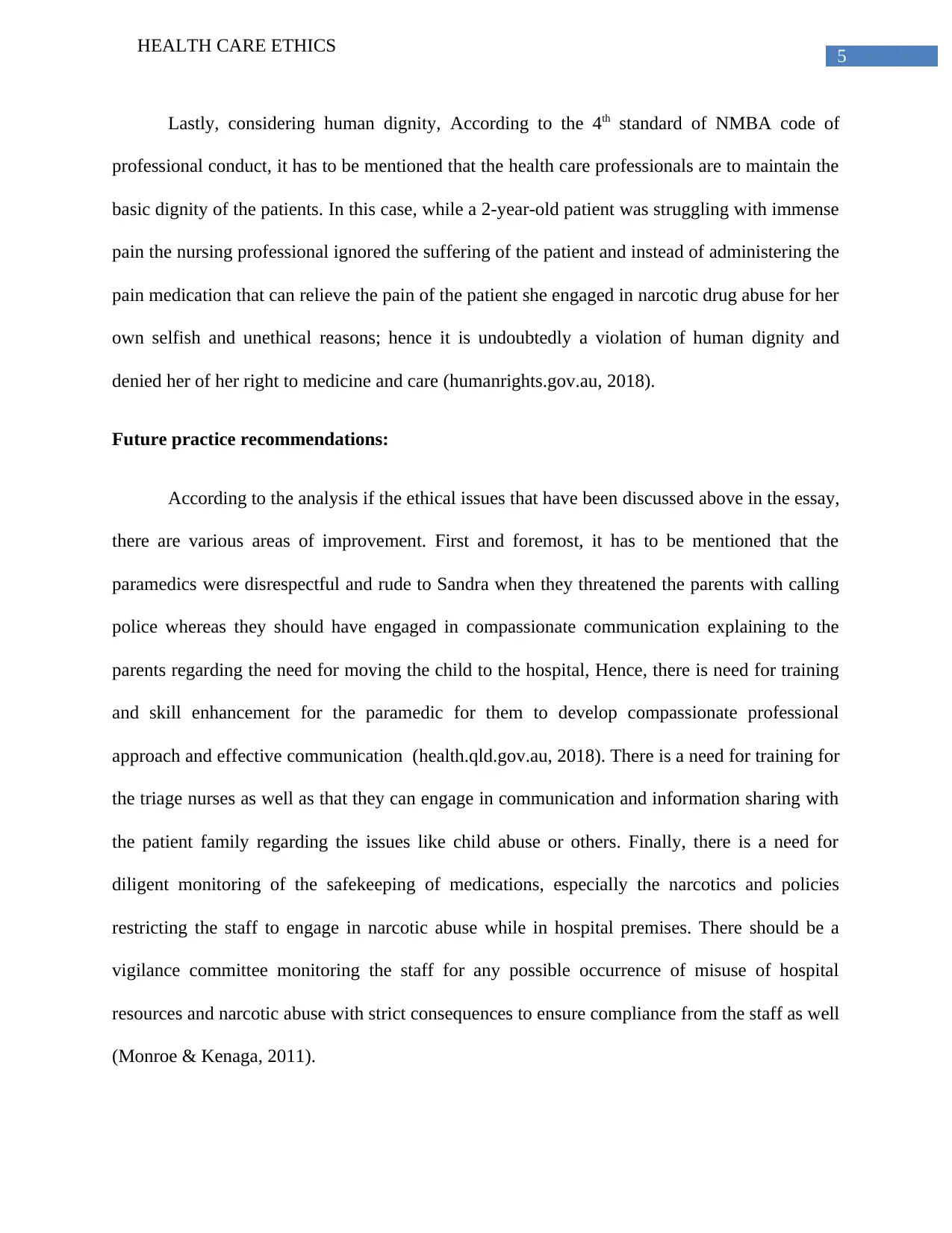
5
HEALTH CARE ETHICS
Lastly, considering human dignity, According to the 4th standard of NMBA code of
professional conduct, it has to be mentioned that the health care professionals are to maintain the
basic dignity of the patients. In this case, while a 2-year-old patient was struggling with immense
pain the nursing professional ignored the suffering of the patient and instead of administering the
pain medication that can relieve the pain of the patient she engaged in narcotic drug abuse for her
own selfish and unethical reasons; hence it is undoubtedly a violation of human dignity and
denied her of her right to medicine and care (humanrights.gov.au, 2018).
Future practice recommendations:
According to the analysis if the ethical issues that have been discussed above in the essay,
there are various areas of improvement. First and foremost, it has to be mentioned that the
paramedics were disrespectful and rude to Sandra when they threatened the parents with calling
police whereas they should have engaged in compassionate communication explaining to the
parents regarding the need for moving the child to the hospital, Hence, there is need for training
and skill enhancement for the paramedic for them to develop compassionate professional
approach and effective communication (health.qld.gov.au, 2018). There is a need for training for
the triage nurses as well as that they can engage in communication and information sharing with
the patient family regarding the issues like child abuse or others. Finally, there is a need for
diligent monitoring of the safekeeping of medications, especially the narcotics and policies
restricting the staff to engage in narcotic abuse while in hospital premises. There should be a
vigilance committee monitoring the staff for any possible occurrence of misuse of hospital
resources and narcotic abuse with strict consequences to ensure compliance from the staff as well
(Monroe & Kenaga, 2011).
HEALTH CARE ETHICS
Lastly, considering human dignity, According to the 4th standard of NMBA code of
professional conduct, it has to be mentioned that the health care professionals are to maintain the
basic dignity of the patients. In this case, while a 2-year-old patient was struggling with immense
pain the nursing professional ignored the suffering of the patient and instead of administering the
pain medication that can relieve the pain of the patient she engaged in narcotic drug abuse for her
own selfish and unethical reasons; hence it is undoubtedly a violation of human dignity and
denied her of her right to medicine and care (humanrights.gov.au, 2018).
Future practice recommendations:
According to the analysis if the ethical issues that have been discussed above in the essay,
there are various areas of improvement. First and foremost, it has to be mentioned that the
paramedics were disrespectful and rude to Sandra when they threatened the parents with calling
police whereas they should have engaged in compassionate communication explaining to the
parents regarding the need for moving the child to the hospital, Hence, there is need for training
and skill enhancement for the paramedic for them to develop compassionate professional
approach and effective communication (health.qld.gov.au, 2018). There is a need for training for
the triage nurses as well as that they can engage in communication and information sharing with
the patient family regarding the issues like child abuse or others. Finally, there is a need for
diligent monitoring of the safekeeping of medications, especially the narcotics and policies
restricting the staff to engage in narcotic abuse while in hospital premises. There should be a
vigilance committee monitoring the staff for any possible occurrence of misuse of hospital
resources and narcotic abuse with strict consequences to ensure compliance from the staff as well
(Monroe & Kenaga, 2011).
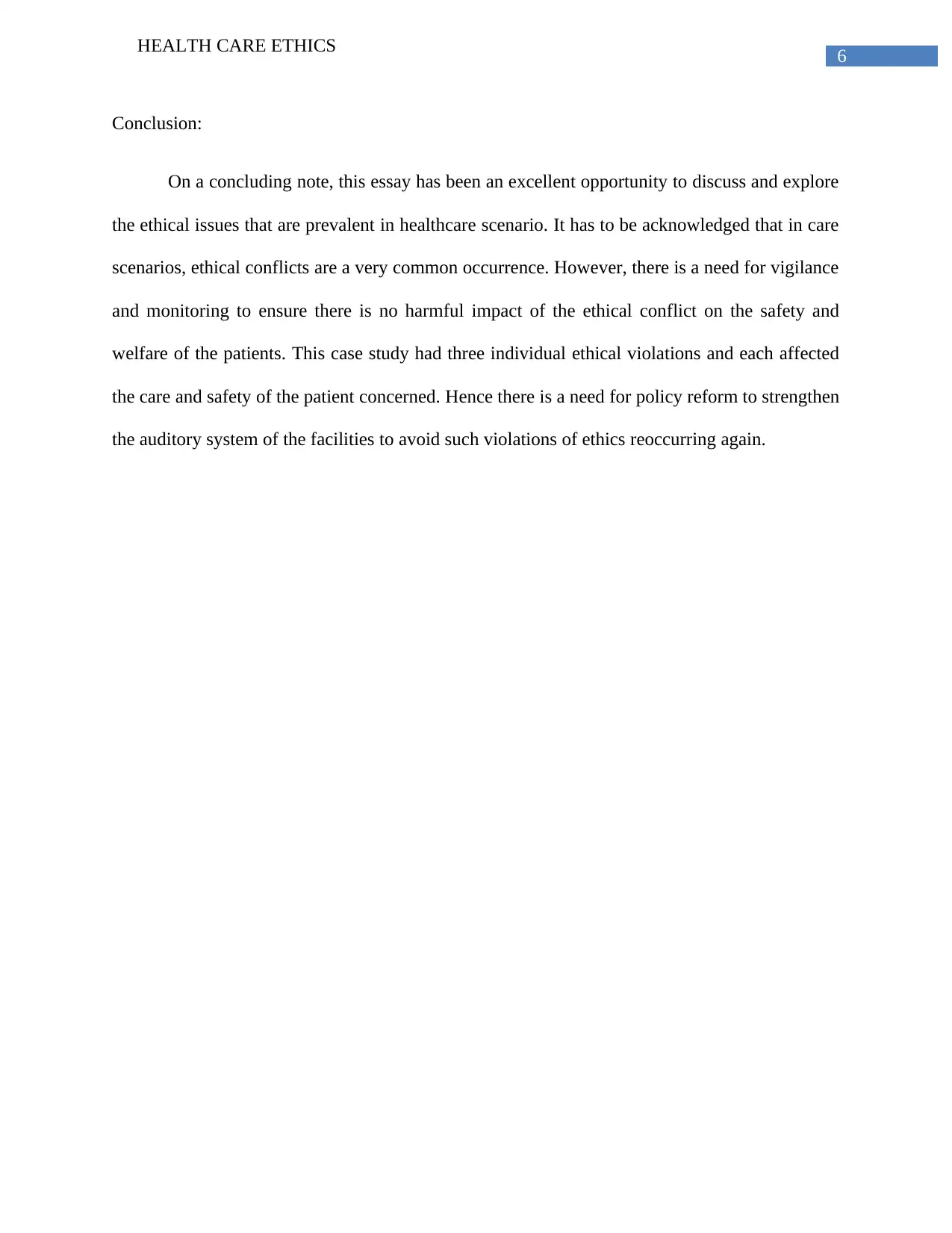
6
HEALTH CARE ETHICS
Conclusion:
On a concluding note, this essay has been an excellent opportunity to discuss and explore
the ethical issues that are prevalent in healthcare scenario. It has to be acknowledged that in care
scenarios, ethical conflicts are a very common occurrence. However, there is a need for vigilance
and monitoring to ensure there is no harmful impact of the ethical conflict on the safety and
welfare of the patients. This case study had three individual ethical violations and each affected
the care and safety of the patient concerned. Hence there is a need for policy reform to strengthen
the auditory system of the facilities to avoid such violations of ethics reoccurring again.
HEALTH CARE ETHICS
Conclusion:
On a concluding note, this essay has been an excellent opportunity to discuss and explore
the ethical issues that are prevalent in healthcare scenario. It has to be acknowledged that in care
scenarios, ethical conflicts are a very common occurrence. However, there is a need for vigilance
and monitoring to ensure there is no harmful impact of the ethical conflict on the safety and
welfare of the patients. This case study had three individual ethical violations and each affected
the care and safety of the patient concerned. Hence there is a need for policy reform to strengthen
the auditory system of the facilities to avoid such violations of ethics reoccurring again.
Paraphrase This Document
Need a fresh take? Get an instant paraphrase of this document with our AI Paraphraser
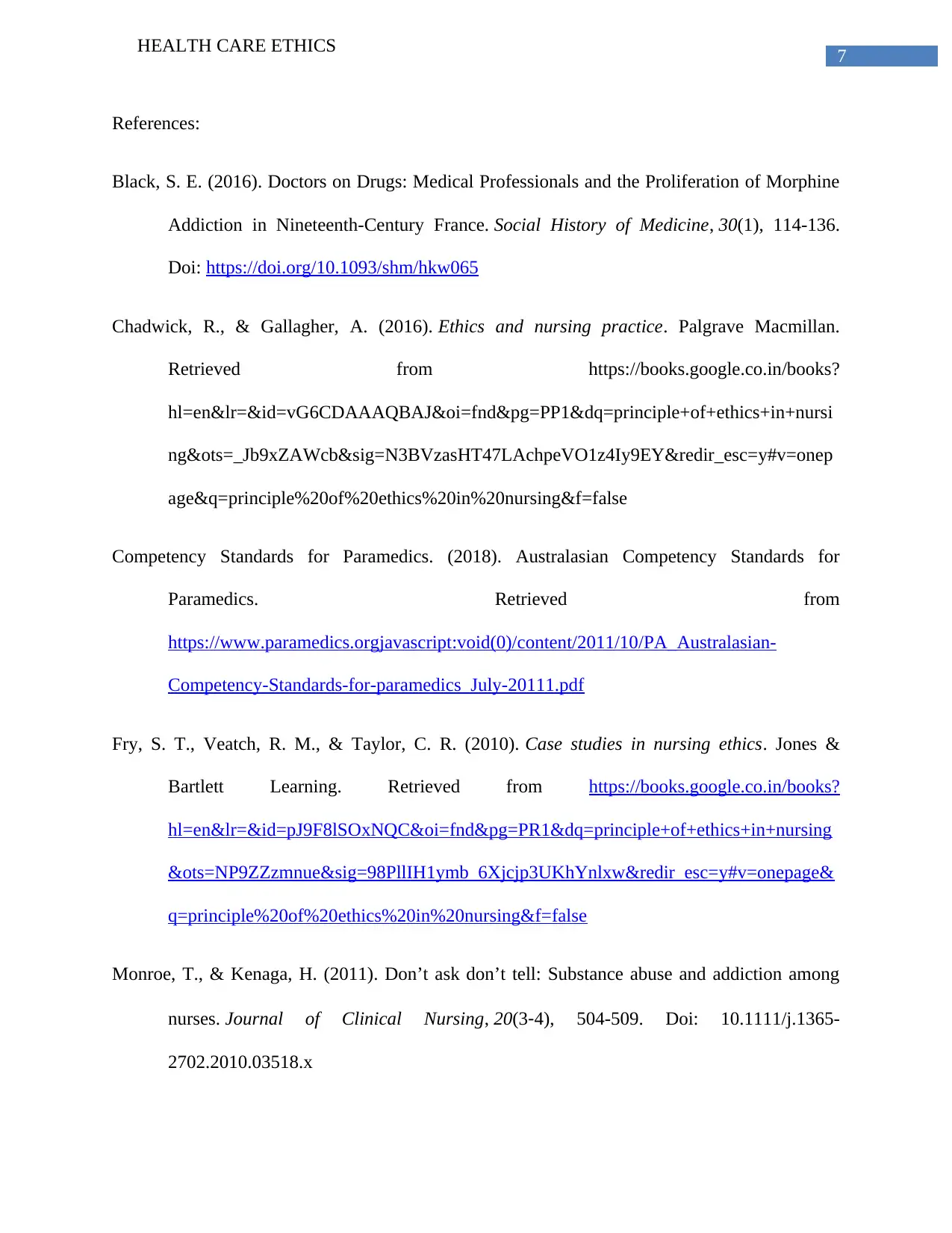
7
HEALTH CARE ETHICS
References:
Black, S. E. (2016). Doctors on Drugs: Medical Professionals and the Proliferation of Morphine
Addiction in Nineteenth-Century France. Social History of Medicine, 30(1), 114-136.
Doi: https://doi.org/10.1093/shm/hkw065
Chadwick, R., & Gallagher, A. (2016). Ethics and nursing practice. Palgrave Macmillan.
Retrieved from https://books.google.co.in/books?
hl=en&lr=&id=vG6CDAAAQBAJ&oi=fnd&pg=PP1&dq=principle+of+ethics+in+nursi
ng&ots=_Jb9xZAWcb&sig=N3BVzasHT47LAchpeVO1z4Iy9EY&redir_esc=y#v=onep
age&q=principle%20of%20ethics%20in%20nursing&f=false
Competency Standards for Paramedics. (2018). Australasian Competency Standards for
Paramedics. Retrieved from
https://www.paramedics.orgjavascript:void(0)/content/2011/10/PA_Australasian-
Competency-Standards-for-paramedics_July-20111.pdf
Fry, S. T., Veatch, R. M., & Taylor, C. R. (2010). Case studies in nursing ethics. Jones &
Bartlett Learning. Retrieved from https://books.google.co.in/books?
hl=en&lr=&id=pJ9F8lSOxNQC&oi=fnd&pg=PR1&dq=principle+of+ethics+in+nursing
&ots=NP9ZZzmnue&sig=98PllIH1ymb_6Xjcjp3UKhYnlxw&redir_esc=y#v=onepage&
q=principle%20of%20ethics%20in%20nursing&f=false
Monroe, T., & Kenaga, H. (2011). Don’t ask don’t tell: Substance abuse and addiction among
nurses. Journal of Clinical Nursing, 20(3‐4), 504-509. Doi: 10.1111/j.1365-
2702.2010.03518.x
HEALTH CARE ETHICS
References:
Black, S. E. (2016). Doctors on Drugs: Medical Professionals and the Proliferation of Morphine
Addiction in Nineteenth-Century France. Social History of Medicine, 30(1), 114-136.
Doi: https://doi.org/10.1093/shm/hkw065
Chadwick, R., & Gallagher, A. (2016). Ethics and nursing practice. Palgrave Macmillan.
Retrieved from https://books.google.co.in/books?
hl=en&lr=&id=vG6CDAAAQBAJ&oi=fnd&pg=PP1&dq=principle+of+ethics+in+nursi
ng&ots=_Jb9xZAWcb&sig=N3BVzasHT47LAchpeVO1z4Iy9EY&redir_esc=y#v=onep
age&q=principle%20of%20ethics%20in%20nursing&f=false
Competency Standards for Paramedics. (2018). Australasian Competency Standards for
Paramedics. Retrieved from
https://www.paramedics.orgjavascript:void(0)/content/2011/10/PA_Australasian-
Competency-Standards-for-paramedics_July-20111.pdf
Fry, S. T., Veatch, R. M., & Taylor, C. R. (2010). Case studies in nursing ethics. Jones &
Bartlett Learning. Retrieved from https://books.google.co.in/books?
hl=en&lr=&id=pJ9F8lSOxNQC&oi=fnd&pg=PR1&dq=principle+of+ethics+in+nursing
&ots=NP9ZZzmnue&sig=98PllIH1ymb_6Xjcjp3UKhYnlxw&redir_esc=y#v=onepage&
q=principle%20of%20ethics%20in%20nursing&f=false
Monroe, T., & Kenaga, H. (2011). Don’t ask don’t tell: Substance abuse and addiction among
nurses. Journal of Clinical Nursing, 20(3‐4), 504-509. Doi: 10.1111/j.1365-
2702.2010.03518.x
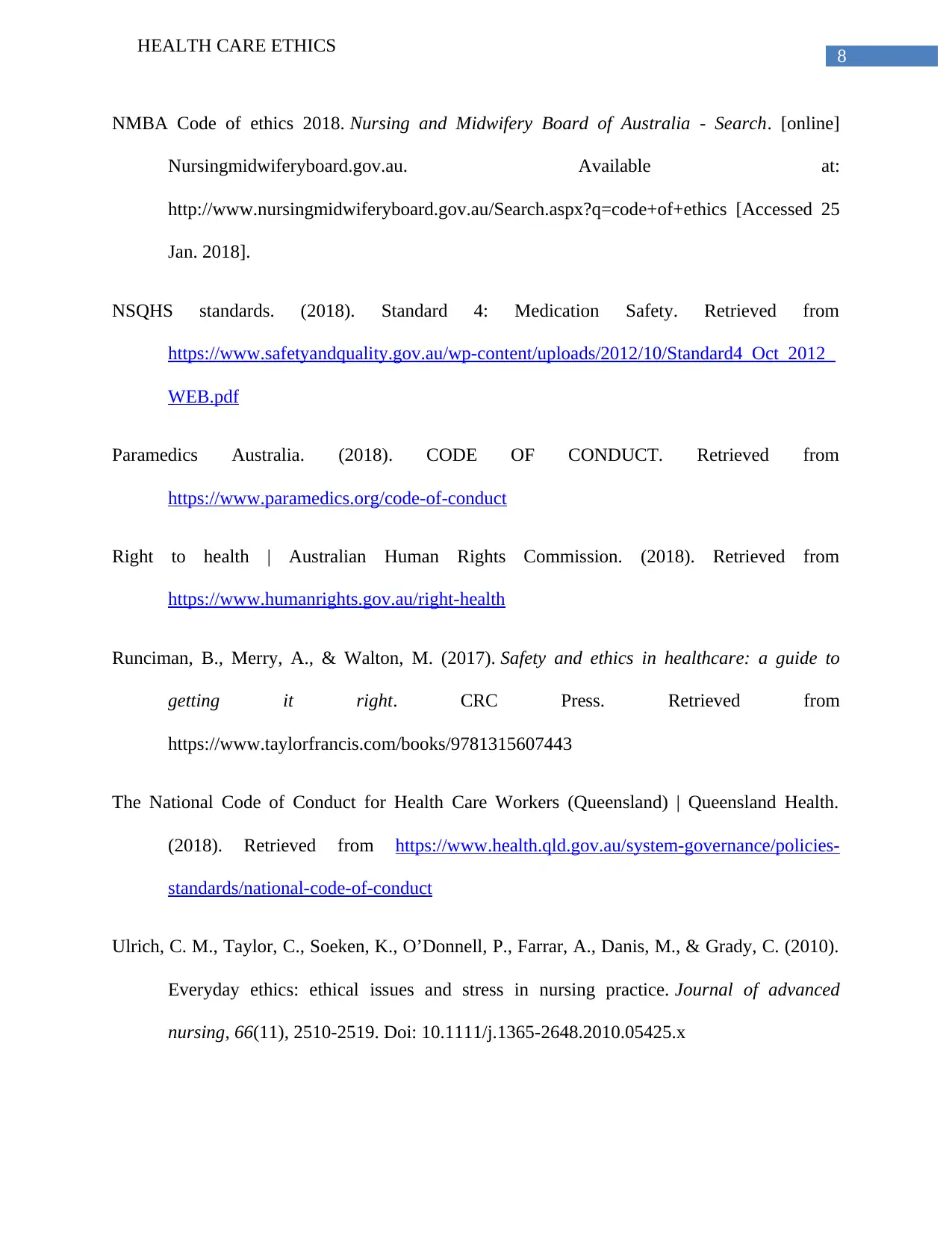
8
HEALTH CARE ETHICS
NMBA Code of ethics 2018. Nursing and Midwifery Board of Australia - Search. [online]
Nursingmidwiferyboard.gov.au. Available at:
http://www.nursingmidwiferyboard.gov.au/Search.aspx?q=code+of+ethics [Accessed 25
Jan. 2018].
NSQHS standards. (2018). Standard 4: Medication Safety. Retrieved from
https://www.safetyandquality.gov.au/wp-content/uploads/2012/10/Standard4_Oct_2012_
WEB.pdf
Paramedics Australia. (2018). CODE OF CONDUCT. Retrieved from
https://www.paramedics.org/code-of-conduct
Right to health | Australian Human Rights Commission. (2018). Retrieved from
https://www.humanrights.gov.au/right-health
Runciman, B., Merry, A., & Walton, M. (2017). Safety and ethics in healthcare: a guide to
getting it right. CRC Press. Retrieved from
https://www.taylorfrancis.com/books/9781315607443
The National Code of Conduct for Health Care Workers (Queensland) | Queensland Health.
(2018). Retrieved from https://www.health.qld.gov.au/system-governance/policies-
standards/national-code-of-conduct
Ulrich, C. M., Taylor, C., Soeken, K., O’Donnell, P., Farrar, A., Danis, M., & Grady, C. (2010).
Everyday ethics: ethical issues and stress in nursing practice. Journal of advanced
nursing, 66(11), 2510-2519. Doi: 10.1111/j.1365-2648.2010.05425.x
HEALTH CARE ETHICS
NMBA Code of ethics 2018. Nursing and Midwifery Board of Australia - Search. [online]
Nursingmidwiferyboard.gov.au. Available at:
http://www.nursingmidwiferyboard.gov.au/Search.aspx?q=code+of+ethics [Accessed 25
Jan. 2018].
NSQHS standards. (2018). Standard 4: Medication Safety. Retrieved from
https://www.safetyandquality.gov.au/wp-content/uploads/2012/10/Standard4_Oct_2012_
WEB.pdf
Paramedics Australia. (2018). CODE OF CONDUCT. Retrieved from
https://www.paramedics.org/code-of-conduct
Right to health | Australian Human Rights Commission. (2018). Retrieved from
https://www.humanrights.gov.au/right-health
Runciman, B., Merry, A., & Walton, M. (2017). Safety and ethics in healthcare: a guide to
getting it right. CRC Press. Retrieved from
https://www.taylorfrancis.com/books/9781315607443
The National Code of Conduct for Health Care Workers (Queensland) | Queensland Health.
(2018). Retrieved from https://www.health.qld.gov.au/system-governance/policies-
standards/national-code-of-conduct
Ulrich, C. M., Taylor, C., Soeken, K., O’Donnell, P., Farrar, A., Danis, M., & Grady, C. (2010).
Everyday ethics: ethical issues and stress in nursing practice. Journal of advanced
nursing, 66(11), 2510-2519. Doi: 10.1111/j.1365-2648.2010.05425.x
1 out of 9
Related Documents
Your All-in-One AI-Powered Toolkit for Academic Success.
+13062052269
info@desklib.com
Available 24*7 on WhatsApp / Email
![[object Object]](/_next/static/media/star-bottom.7253800d.svg)
Unlock your academic potential
© 2024 | Zucol Services PVT LTD | All rights reserved.




